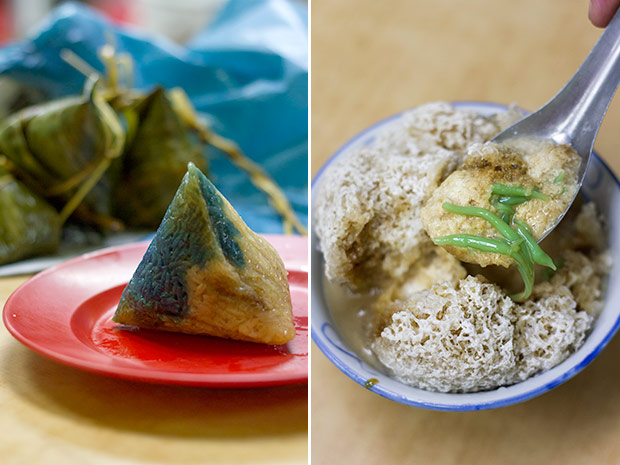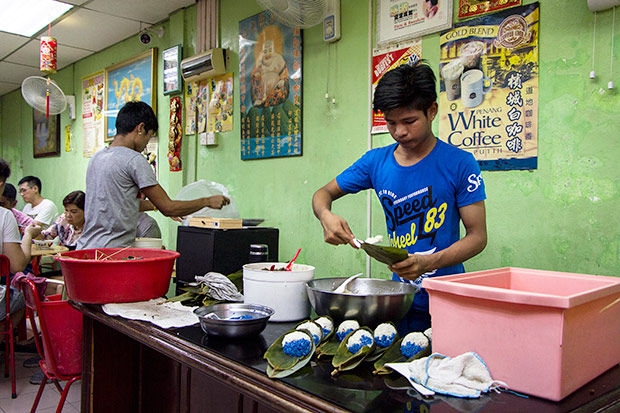MALACCA, Sept 11 — My friends often ask me what is my one must-have Malaccan delicacy whenever I return to my hometown. Is it satay celup, that communal dish of dipping skewers of various foods into a bubbling pot of spicy peanut gravy? Or perhaps Malaccan-style asam pedas, a hot and sour fish stew enriched with tamarind and chunks of pineapple?
Both are good guesses but my answer, invariably, is Nyonya chang. This is the Peranakan variety of the famous bak chang (literally “meat dumpling” in Hokkien), a sticky rice dumpling traditionally eaten during the Duanwu Festival (also known as the Dragon Boat Festival).
The festival falls on the fifth day of the fifth month of the Chinese lunar calendar — usually late May to mid-June — but these dumplings are eaten all year round nowadays.
Legend has it that the practice of eating chang (or zongzi, as they are known in China) originated from the death of Qu Yuan, a celebrated poet during the time of the Warring States in ancient China.

Qu Yuan drowned himself in the Miluo River out of grief after his country, the Chu kingdom, was occupied by the opposing Qin invaders. The Chu people threw packets of rice — the chang dumplings we know today — into the river to prevent the fishes from consuming the patriotic poet’s corpse.
In China, the zongzi is made from glutinous rice filled with different ingredients and wrapped in large bamboo leaves before being steamed or boiled. The stuffing ranges from savoury (e.g. waxed sausages, fat cuts of pork, salted duck egg yolks and mushrooms) in the south to sweet (e.g. mung bean paste and red bean paste) in the north.
Here in Malaysia, our bak chang takes after the Southern-style zongzi as the ancestors of the local Hokkien Chinese hailed from the province of Fujian in South-eastern China. So one can expect mouthwatering bits of pork belly, umami-dense shiitake mushrooms and a rich salted duck egg yolk or two in one’s bak chang.
Not so with a Nyonya chang, which I prefer. The Peranakan home cooks of yesteryear have replaced this purely savoury stuffing with a more balanced blend of sweet and salty: minced pork, candied winter melon, mushrooms and rempah (spices — the mix usually a secret recipe depending on the family).
Even before you cut open your Nyonya chang, it stands out from the more common bak chang by virtue of its colour. The latter tends to be a homogeneous shade of yellow or brown.

A true-blue Nyonya chang, however (if you’d pardon the pun), always has a lovely tinge of blue, stark against the more conventional canvas of white or pale yellow glutinous rice. This natural blue colour comes from the cooked liquid of bunga telang (also known as blue pea or butterfly pea flowers).
In fact, I remember as a child being instructed by my mother to pluck the bunga telang blossoms — as many as I could carry in a woven basket — to give to Sa Kim, my mother’s third aunt.
Sa Kim was an expert at making all manner of chang, from the plain, alkaline-tasting kee chang (more commonly known as kansui zong in Cantonese) that go so well with some homemade kaya to decadently rich bak chang.
But we all agreed that the one sticky rice dumpling she excelled at making was Nyonya chang, neither too sweet nor salty but just nice. With the passage of time and poor health, Sa Kim stopped making chang and neither my mother nor I ever mastered the art of folding the bamboo leaves to form a packet to hold the glutinous rice and stuffing.

Fortunately, I found a shop that not only sold freshly-made Nyonya chang but one that made an authentic version, without stingeing on the ingredients. Located along Lorong Hang Jebat, perpendicular to the more touristy Jonker Street (Jalan Hang Jebat), East & West Rendezvous Café sells a variety of Peranakan delicacies including Nyonya kuih (such as the spicy rempah udang) and a very decent cendol made with 100 per cent gula Melaka syrup that rivals the more popular ones along Jonker Street.

What almost everyone comes here for, though, is East & West Rendezvous Café’s redoubtable Nyonya chang, arguably the best I’ve had outside a home kitchen.

In fact, as you enter the shop, you may observe workers busy making dozens of these delicious dumplings, reminding me how making chang used to be a family activity where everyone helped out. (My sole contribution, given my lack of chang wrapping skill, was limited to hunting down the bunga telang, as mentioned earlier. That, and devouring the results.)

On the work table are two large mixing bowls, one with plain white rice and one with rice dyed blue with bunga telang. The workers first fold the pre-soaked bamboo leaves into a cone before spooning in some blue and white rice. Next they add the stuffing before covering it with more spoonfuls of the blue and white rice.
Folding the leaf to cover the top, forming a roughly tetrahedral shape, they finally tie up the packet with some bamboo string. The uncooked dumplings are tied in groups of ten, to make removing them after cooking them more convenient.

The best way to enjoy Nyonya chang is to grab a table, sit down and await your order of freshly cooked dumplings. For me, there is no other Nyonya kuih quite as beautiful: the white-and-blue exterior opening up to reveal a treasure trove of aromatic and slightly peppery minced pork belly and pork fat, candied winter melon and shiitake mushrooms. This, for me, is the taste of my hometown.
East & West Rendezvous Café
60, Lorong Hang Jebat, Malacca
Open daily 9:30am to 5:30pm
Tel: 016-634 6283
Note: Call ahead to order if planning to buy bulk for takeaway. Nyonya chang can be kept in the freezer for months and reheat nicely in a steamer.






















